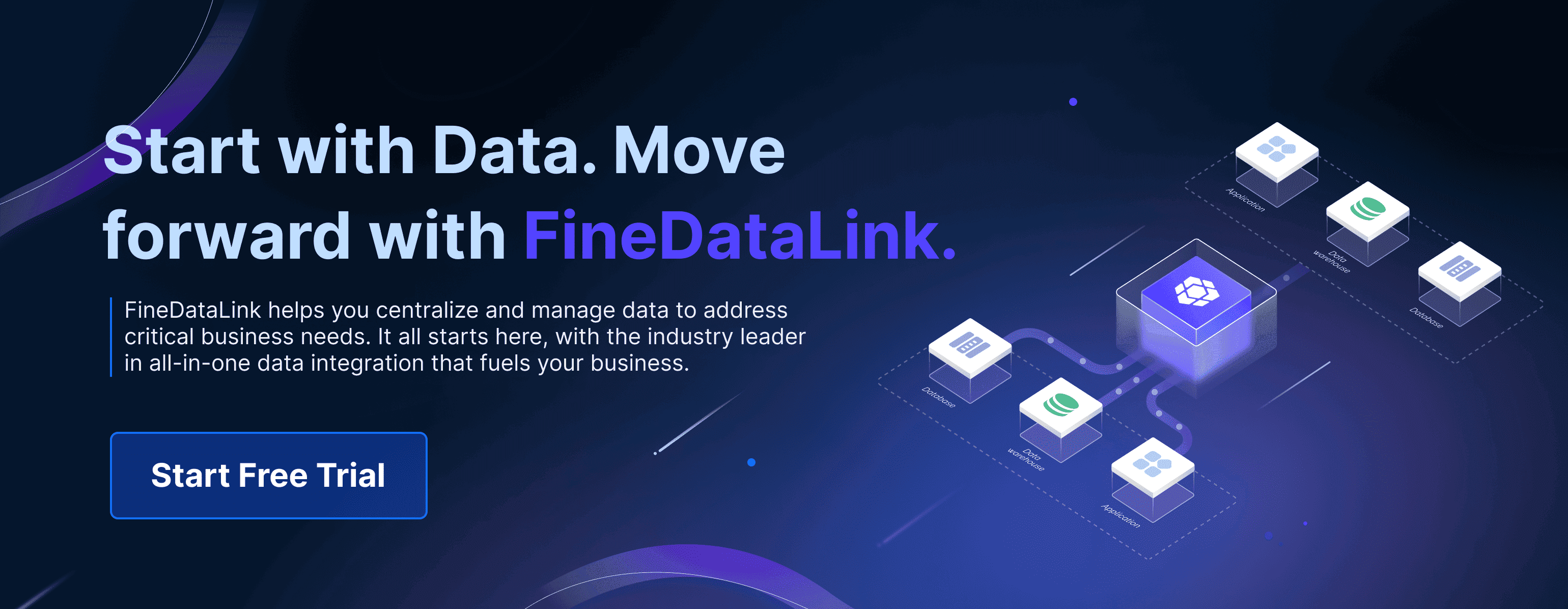You face an ever-expanding landscape of data warehousing solutions in 2025. Leading platforms such as Microsoft Azure Synapse Analytics, Oracle Autonomous Data Warehouse, Snowflake, SAP Datasphere, and AWS Redshift dominate the market, as shown below:
| Company | Market Share (2024) | Key Product | User Adoption Growth | Notable Adoption Segment |
|---|---|---|---|---|
| Microsoft | 18% | Azure Synapse Analytics | +39% | Largest market share overall |
| Oracle | 16% | Autonomous Data Warehouse | +27% | Usage growth among Fortune 500 firms |
| SAP | N/A | SAP Datasphere | N/A | Cloud data warehouse with enhanced data cataloging |
| Snowflake | N/A | Snowflake Platform | N/A | Data sharing and collaboration tools |
| AWS | N/A | Redshift | N/A | Machine learning features for predictive insights |
You need the right data warehouse to unlock insights and drive business intelligence. The rise of cloud data warehouse adoption and integration platforms like FineDataLink empowers you to connect, synchronize, and analyze data efficiently.
Data Warehousing Solutions Overview
What Is a Data Warehouse?
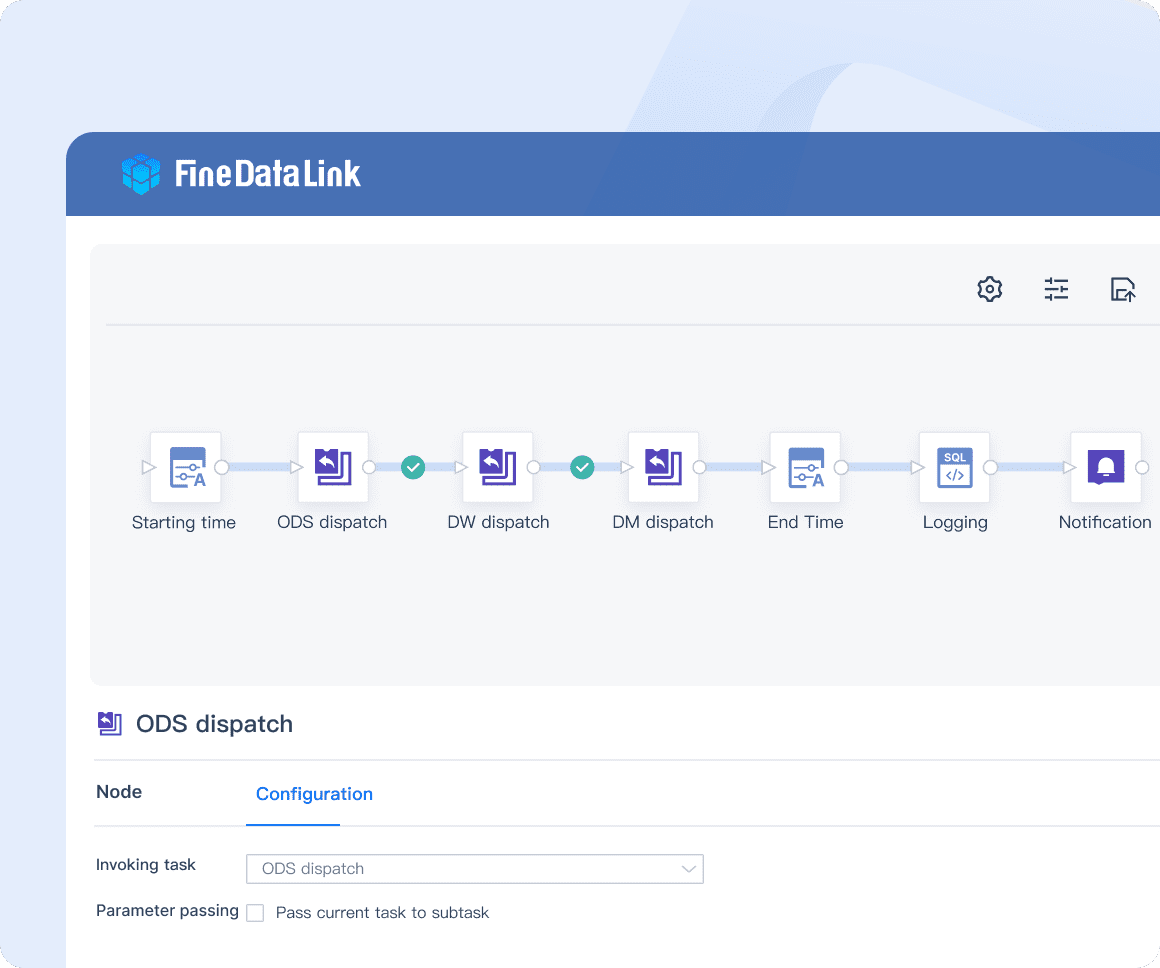
You rely on a data warehouse to collect, organize, and store large volumes of information from different sources. This system acts as the backbone for your business intelligence and reporting needs. In 2025, you can choose from several types of data warehousing solutions, each designed for specific requirements:
- Enterprise Data Warehouse (EDW): This centralized platform brings all your organizational data together for unified access.
- Operational Data Store (ODS): You use this for current or near-real-time reporting, supporting daily operations.
- Data Mart: This solution focuses on specific business lines or teams, offering tailored data storage and analysis.
A modern data warehouse includes several core components:
- Data sources: These feed raw data from systems like CRM, ERP, or social media.
- Data ingestion: This process extracts, cleanses, and validates your data.
- Data storage: You benefit from scalable technologies, such as cloud object storage or distributed file systems.
- Data processing engine: This enables fast querying and complex analysis.
- Metadata management: You gain insights into data structure and quality.
- Real-time data integration: This supports near real-time updates.
- Data quality management: This ensures your data remains accurate and reliable.
- Data governance and security: You control access, maintain compliance, and protect sensitive information.
You see differences among data warehousing solutions in their architecture, integration methods, and focus areas like real-time data handling, scalability, and governance. Cloud-native platforms, real-time streaming, and AI-powered modeling tools now shape the landscape.
Why Data Warehousing Solutions Matters
You need a data warehouse to drive better business outcomes. Centralized data storage eliminates silos and gives you unified access across departments. This setup allows you to retrieve information quickly, which leads to faster decision-making. Many companies report higher efficiency and productivity after adopting modern data warehousing.
You also improve data quality by transforming raw information into accurate insights. Flexible data storage platforms, such as Amazon Redshift, Snowflake, and Google BigQuery, help you scale as your needs grow. Cost-efficiency improves because you reduce redundancies and cut maintenance expenses.
A data warehouse supports your analysis in many areas:
- Enhanced business intelligence: You optimize customer experience and increase profits.
- Applicability across operations: You improve sales, marketing, risk management, and finance.
- High return on investment: You save costs and enable customized solutions.
- Time savings: You monitor KPIs centrally and make decisions faster.
- Forecasting: You use data to predict revenue and optimize performance.
- Effective decision-making: You turn unstructured data into meaningful analysis and visualizations.
You see these benefits in industries like retail, finance, healthcare, and government, where data storage and analysis drive innovation and growth.
Key Criteria for Data Warehouse Solutions
Scalability and Performance
You need a data warehouse that grows with your business. Cloud-based data storage offers near-infinite scalability and lets you handle more users and larger datasets without major upgrades. Leading platforms like Snowflake, Google BigQuery, and Microsoft Azure Synapse Analytics provide elastic scaling and fast query performance. For example, Google BigQuery uses a serverless model, so you do not manage infrastructure and can run real-time analysis with ease. On-premise solutions give you control but often require costly hardware upgrades and have slower scaling.
Tip: Always check performance benchmarks for your specific workloads. Some platforms excel at batch processing, while others shine in real-time analytics.
Integration and Connectivity
You want your data warehouse to connect with all your tools and systems. Broad integration capabilities allow you to pull data from SaaS apps, databases, and cloud services. Solutions like Talend, Informatica, and SnapLogic offer hundreds of connectors, making data integration and data management much easier. This flexibility supports seamless data storage and analysis across your organization.
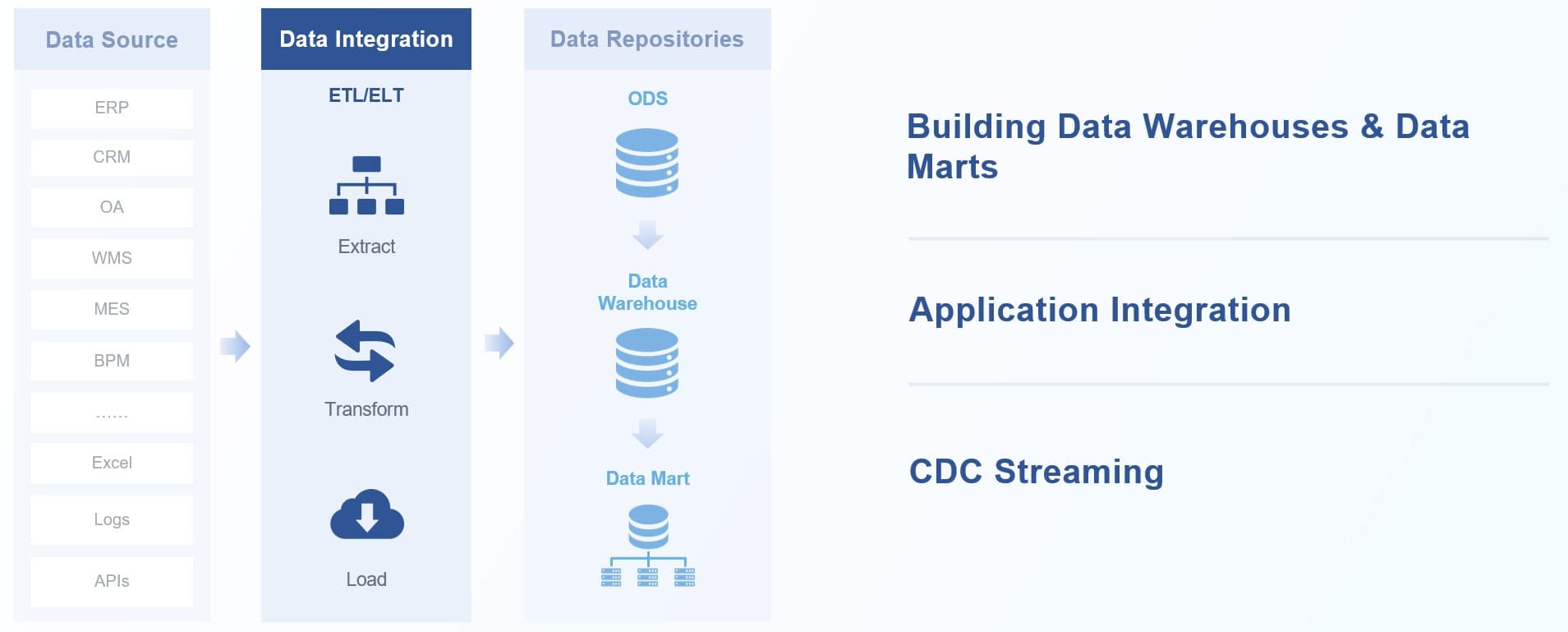
Security and Compliance
Data security is critical for every business. Top data warehouse providers support certifications like SOC 2, ISO 27001, and HITRUST. These standards ensure your data storage meets strict requirements for privacy, risk management, and regulatory compliance. You should look for features such as encryption, identity management, and continuous monitoring. These measures protect your data storage and help you avoid costly breaches.
- SOC 2: Focuses on Data security, availability, and confidentiality.
- ISO 27001: Sets a global standard for information security management.
- HITRUST: Combines multiple standards for comprehensive compliance.
Cost and Pricing
You need a clear understanding of costs before choosing a data warehouse. Cloud solutions use pay-as-you-go or consumption-based pricing, which helps you control expenses and scale as needed. For example, Snowflake charges by compute and storage usage, while Google BigQuery uses pay-per-query pricing. On-premise options require higher upfront investment for hardware and ongoing maintenance. For mid-sized businesses, total costs can range from $30,000 to over $1,000,000, depending on complexity and data storage needs.
Ease of Use
You want a data warehouse that your team can use without steep learning curves. Platforms like Snowflake and SAP Data Warehouse Cloud offer intuitive interfaces, self-service analytics, and minimal setup. These features help both IT professionals and business analysts manage data storage, perform analysis, and generate reports quickly. Easy-to-use solutions speed up adoption and improve data management across your company.
Comparison Table: Leading Data Warehousing Solutions
When you evaluate data warehousing solutions in 2025, you see a landscape shaped by innovation, scalability, and integration. Each cloud data warehouse offers unique strengths, so you need to match your business needs with the right platform. The table below gives you a side-by-side look at the top data warehouse options and their integration capabilities.
| Solution | Key Features & Architecture | Performance & Scalability | Integration & Ecosystem | Cost Model | Key Differentiator |
|---|---|---|---|---|---|
| Snowflake | Multi-cluster, cloud-agnostic, strong governance | High, adaptive compute | AWS, Azure, GCP, 3rd-party tools | Compute credits + storage | Simplicity, secure data sharing |
| Google BigQuery | Serverless, embedded AI, semantic search | High, automatic scaling | Deep GCP integration | Pay-per-query or flat-rate | True serverless, embedded AI |
| Amazon Redshift | MPP, serverless option, AWS integration | High, manual or auto-scaling | Deep AWS ecosystem | Node-hour or RPU | Machine learning, S3 integration |
| Azure Synapse Analytics | Hybrid pools, tight Azure integration | High, flexible scaling | Deep Azure ecosystem | DWU hour or per TB | Unified analytics, Power BI integration |
| Oracle Autonomous Data Warehouse | Autonomous, Exadata-based, security focus | High, automated scaling | Oracle Cloud ecosystem | OCPU/hr + storage | Automation, security, Oracle integration |
| SAP Data Warehouse | Enterprise-focused, legacy integration | Enterprise scale | SAP ecosystem, legacy systems | Enterprise licensing | Data cataloging, SAP integration |
| Databricks Lakehouse | Spark-based, supports all data types, AI/ML | High, cluster auto-scaling | Multi-cloud, open ecosystem | DBU per second + storage | Real-time, ACID transactions, AI/ML |
| FanRuan FineDataLink | Real-time sync, ETL/ELT, 100+ connectors | Scalable, low-latency pipelines | 100+ sources, SaaS, APIs | Affordable, flexible | Visual low-code, real-time integration |
Note: You gain flexibility with cloud data warehouse platforms that support multi-cloud and hybrid environments. Lakehouse architectures, like Databricks, let you handle all data types and support real-time analytics. FineDataLink stands out as a modern integration platform, helping you build both offline and real-time data warehouses with ease.
You notice that cloud data warehouse solutions now focus on automation, embedded AI, and seamless integration. Snowflake and BigQuery lead with serverless models and adaptive scaling. Redshift and Synapse offer deep ecosystem ties, while Databricks Lakehouse brings advanced analytics and real-time data handling. FanRuan FineDataLink empowers you to connect, synchronize, and transform data across over 100 sources, making it a strong choice for integration in your data warehouse strategy.
In-Depth Reviews of Top Data Warehousing Solutions
Snowflake
Snowflake stands out as a cloud-native data warehouse that delivers high performance and flexibility. You benefit from its multi-cluster architecture, which supports elastic scaling and rapid query execution. Security remains a top priority, with features like encryption and compliance with major standards. Snowflake’s Time Travel and Fail-safe functions help you recover data and maintain business continuity.
| Aspect | Details |
|---|---|
| Strengths | - Strong security and compliance - Time Travel and Fail-safe for data recovery - High performance with micro-partitioning and caching - Elastic scalability with auto-scaling - Multi-cloud support (AWS, Azure, GCP) - Pay-per-use pricing - Developer-friendly with Snowpark and Snowsight |
| Weaknesses | - No on-premises deployment; cloud-only - Unpredictable pricing if not monitored - Smaller user community - Limited native machine learning capabilities - Complexity in migrating from legacy systems |
| Ideal Use Cases | - High concurrency workloads - Scenarios needing rapid scaling - Organizations requiring strong security - Real-time and batch data processing - Data sharing and collaboration - Multi-cloud analytics environments |
You should consider Snowflake if you need a flexible, secure, and high-performing data warehouse for both real-time and batch analysis.
Google BigQuery
Google BigQuery offers a serverless data warehouse that scales automatically to handle massive datasets. You do not need to manage infrastructure, which allows you to focus on analysis and insights. BigQuery integrates deeply with Google Cloud services and supports real-time streaming analytics.
| Aspect | Details |
|---|---|
| Strengths | - Serverless architecture with automatic scaling - High performance on large datasets - Deep integration with Google Cloud - SQL-centric approach with BigQuery ML - Real-time streaming analytics - Built-in machine learning - Cost-effective on-demand pricing - Polyglot APIs for flexible ETL and querying |
| Weaknesses | - Not suitable for OLTP workloads - Limited infrastructure tuning - Potential cost unpredictability - Google Cloud ecosystem lock-in - Partition count restrictions - Some SQL feature gaps |
| Ideal Use Cases | - Enterprise data warehousing - Real-time data ingestion and streaming - Machine learning and predictive modeling - Geospatial data analysis - Marketing analytics - Organizations seeking minimal operational overhead |
You will find BigQuery ideal if you want a data warehouse that supports large-scale, real-time analysis and machine learning, especially within the Google Cloud ecosystem.
Amazon Redshift
Amazon Redshift provides a robust, cloud-based data warehouse with strong integration into the AWS ecosystem. You can scale your storage and compute resources as your needs grow. Redshift’s columnar storage and MPP architecture deliver high performance for complex queries.
| Category | Details |
|---|---|
| Strengths | - High performance with columnar storage and MPP - Scalable by adding/removing nodes - Cost-effective pay-as-you-go pricing - Strong security (encryption, IAM, VPC) - Easy integration with AWS services - Automation for repetitive tasks - Fast deployment and global reach - Consistent backups - Support for open data formats - Robust partner ecosystem |
| Weaknesses | - Initial data loading can be slow and costly - Limited concurrency (max ~500 queries) - Schema inflexibility - Limited indexing options - Risk of duplicate data due to lack of uniqueness enforcement |
| Ideal Use Cases | - Business intelligence and reporting - Centralized data warehousing - Machine learning data preparation - ETL workflows - IoT and sensor data analytics - Log data processing |
You should choose Redshift if you want a scalable, secure data warehouse that integrates seamlessly with AWS and supports large-scale analytics.
Microsoft Azure Synapse Analytics
Azure Synapse Analytics delivers a unified platform for data integration, warehousing, and big data analytics. You can run SQL, Spark, and Data Explorer workloads in one environment. Deep integration with Azure services and Power BI enhances your analytics capabilities.
| Aspect | Evidence Summary |
|---|---|
| Strengths | - Unified platform for SQL, Spark, Data Explorer, and Pipelines - Scalable to petabyte workloads - Deep Azure integration (ADLS Gen2, Power BI, Azure ML) - Hybrid querying across data lakes and warehouses - Robust security - Mature SQL engine with T-SQL compatibility |
| Weaknesses | - Complexity and steep learning curve - Cost management challenges - Requires specialized expertise for tuning - Some operational limitations - Evolving T-SQL differences |
| Ideal Use Cases | - Large-scale enterprise data warehousing - Unified analytics platforms - Organizations invested in Azure - Hybrid data scenarios - Modern data warehouse architectures - Machine learning integration |
You will benefit from Synapse Analytics if you need a comprehensive data warehouse that supports hybrid data scenarios and advanced analytics within the Azure ecosystem.
Oracle Autonomous Data Warehouse
Oracle Autonomous Data Warehouse automates many administrative tasks, reducing manual intervention and errors. You gain high security, fast performance, and the ability to scale compute and storage independently. The platform supports multiple data models and integrates with Oracle Cloud and other major clouds.
- Strengths:
- Fully autonomous operation with self-patching, self-tuning, and self-repairing
- Built-in machine learning for performance and security
- High security with automated threat detection
- Fast query performance with adaptive indexing
- Independent scaling of compute and storage
- Multi-model data support (SQL, JSON, graph, geospatial, text, vectors)
- Seamless integration with Oracle Cloud and compatibility with AWS, Azure, Google Cloud
- Weaknesses:
- Best suited for Oracle-specific ecosystems
- Potentially higher costs for smaller businesses
- Requires Oracle expertise for optimal use
- Ideal Use Cases:
- Enterprises needing robust, hands-free data management
- High-performance analytics on large, diverse datasets
- Real-time analytics and business intelligence
- Compliance, reporting, and predictive analytics
- In-database machine learning and graph analytics
- Organizations aiming to reduce operational complexity
You should consider Oracle Autonomous Data Warehouse if you want a fully managed, secure, and high-performing solution for complex analytics and compliance needs.
SAP Data Warehouse
SAP Data Warehouse, especially SAP Datasphere, focuses on real-time access, business collaboration, and deep integration with SAP ERP and analytics tools. You can use low-code options and modular components to adapt to your organization’s needs.
| Aspect | SAP Datasphere Strengths | Weaknesses / Challenges | Ideal Use Cases |
|---|---|---|---|
| Real-time Data Access | Supports real-time access and data federation | N/A | Enterprises needing up-to-date analytics |
| Usability for Business | Designed for collaborative, business-driven use | N/A | Business users requiring self-service and collaboration |
| Flexibility and Agility | High modularity, low-code/no-code options | N/A | Organizations with hybrid SAP-centric data landscapes |
| Integration | Deep integration with SAP ERP and SAP Analytics Cloud | Complexity in migration from legacy systems | Enterprises heavily invested in SAP ecosystem |
| Data Model Consistency | Unified semantic model bridging IT and business | Early gaps in enterprise-grade capabilities | Businesses needing consistent, governed data views |
You will find SAP Data Warehouse ideal if your organization relies on SAP systems and needs real-time, collaborative analytics with strong governance.
Databricks Lakehouse
Databricks Lakehouse combines the scalability of data lakes with the reliability and governance of a data warehouse. You can manage both structured and unstructured data, run real-time analytics, and support advanced machine learning projects.
| Aspect | Evidence Summary |
|---|---|
| Strengths | - Unified architecture for data lake and data warehouse - ACID transactions and data quality checks - Supports structured and unstructured data - Strong governance with Unity Catalog - Scalable across AWS, Azure, GCP - Collaboration features (shared notebooks, multi-language support) - Advanced machine learning and MLOps support |
| Weaknesses | - Complexity and steeper learning curve - Requires data engineering and data science expertise |
| Ideal Use Cases | - Large-scale data warehousing and business intelligence - ETL/ELT pipelines - Real-time analytics and streaming - Data science and machine learning - Enterprises seeking a modern, flexible data stack |
You should choose Databricks Lakehouse if you need a unified platform for diverse data types, real-time analytics, and advanced machine learning.
FanRuan FineDataLink Integration Platform
FanRuan FineDataLink serves as a modern data integration platform that empowers you to build both offline and real-time data warehouses. You can synchronize data across more than 100 sources with minimal latency. The platform’s visual, low-code interface makes it easy for you to design and manage data pipelines without extensive coding.
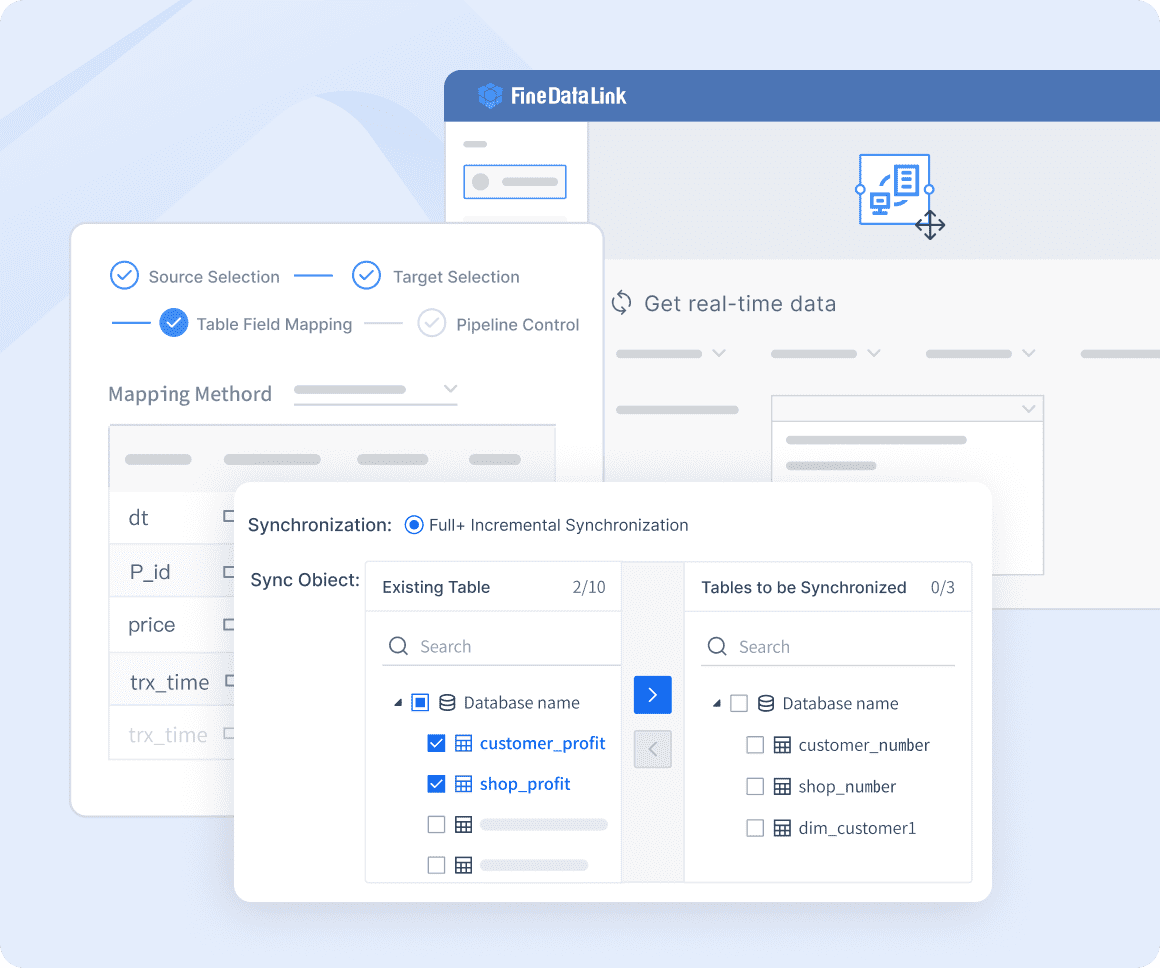
Key strengths include:
- Real-time data integration: You can synchronize business databases in milliseconds, supporting real-time analytics and reporting.
- ETL/ELT capabilities: You can preprocess, transform, and load data efficiently, which is essential for building robust data warehouse solutions.
- API integration: You can develop and launch APIs in minutes, enabling seamless data sharing between systems and SaaS applications.
- Broad connectivity: You can integrate data from SaaS, cloud, and on-premises sources, breaking down silos and improving data quality.
- User-friendly design: The drag-and-drop interface and detailed documentation help you accelerate deployment and reduce operational complexity.
- Scalability: You can handle large data volumes and complex workflows, making FineDataLink suitable for enterprise-level integration.
You will find FineDataLink especially valuable if you need to unify data from multiple sources, automate ETL/ELT processes, and support both real-time and offline data warehouse construction. The platform’s flexibility and ease of use make it a strong choice for organizations seeking efficient, scalable, and modern data integration.
Cloud Data Warehousing Solutions Trends in 2025
Real-Time Analytics
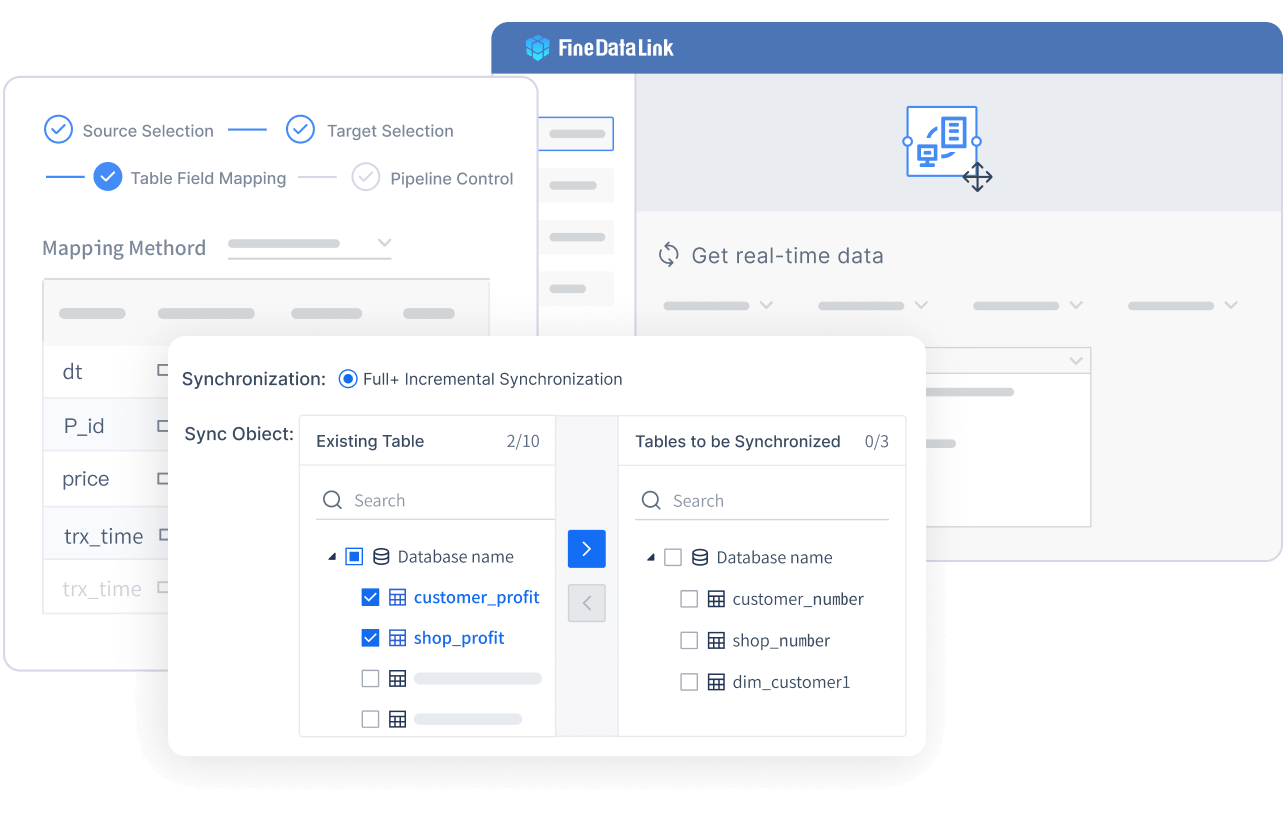
You now expect instant insights from your cloud data warehouse. Real-time analytics has become a necessity, not a luxury. You can ingest, process, and analyze data as it arrives, which means you act on information without delay. Modern cloud data warehouse platforms use streaming and in-memory computing to deliver these capabilities. You see this shift as organizations move away from batch processing. Real-time analytics supports self-service, so you and your team can access up-to-date data for faster decision-making. Providers address challenges like security and integration complexity, making it easier for you to trust and use these solutions.
Note: Real-time analytics in a cloud data warehouse helps you respond to business changes immediately, giving you a competitive edge.
| Feature | Traditional Data Warehouse | Cloud-Based Data Warehouse |
|---|---|---|
| Deployment | On-premise, managed by IT | Public cloud, managed by provider |
| Scalability | Limited, manual upgrades | Virtually limitless, instant scaling |
| Cost Structure | High upfront and maintenance costs | Pay-as-you-go, lower operational costs |
| Performance | Hardware-dependent | Distributed, parallel processing |
| Data Types Supported | Primarily structured | Structured, semi-structured, unstructured |
| Upgrades & Maintenance | Manual, resource-intensive | Automatic, provider-managed |
| Disaster Recovery | Requires planning | Built-in, managed by provider |
| Integration | Complex, often siloed | Easier, cloud-native connectivity |
AI and Automation
You benefit from AI and automation in every modern cloud data warehouse. AI automates ETL and ELT workflows, so you integrate data in real time with less manual work. You see AI optimize queries, predict trends, and detect anomalies, which improves both performance and data quality. Automation reduces your operational overhead and speeds up data readiness. Cloud data warehouse platforms embed machine learning, so you gain predictive insights and smarter data analytics. You also use AI-driven governance tools to ensure compliance and reliable data. DataOps and MLOps frameworks help you deploy and monitor AI models, making your data warehouse smarter and more efficient.
- AI automates data ingestion, transformation, and governance.
- Automation enables real-time analytics and predictive insights.
- AI-driven data warehouses self-optimize for performance and cost.
- You use natural language queries for easier access to data analytics.
Data Lakehouse and Hybrid Approaches
You see enterprises adopt data lakehouse and hybrid models to get the best of both worlds. A data lakehouse combines the scalability and flexibility of a data lake with the performance and governance of a data warehouse. You store structured, semi-structured, and unstructured data in one place, which simplifies your data management. Cloud data warehouse platforms now support real-time analytics and machine learning from a unified environment. You reduce data silos and improve data quality with ACID transactions and strong governance. Hybrid approaches let you use both cloud and on-premises resources, so you meet security and compliance needs while supporting advanced data analytics.
- Data lakehouses centralize diverse data types and support ACID transactions.
- You enable real-time analytics and machine learning from a single platform.
- Hybrid models offer scalable, secure, and efficient data management.
- Enhanced metadata and governance allow you to control access and comply with regulations.
You now rely on a cloud data warehouse for elastic scaling, high availability, and cost savings. These trends shape the future of data analytics and business analysis, helping you make smarter decisions faster.
Choosing the Right Data Warehousing Solutions
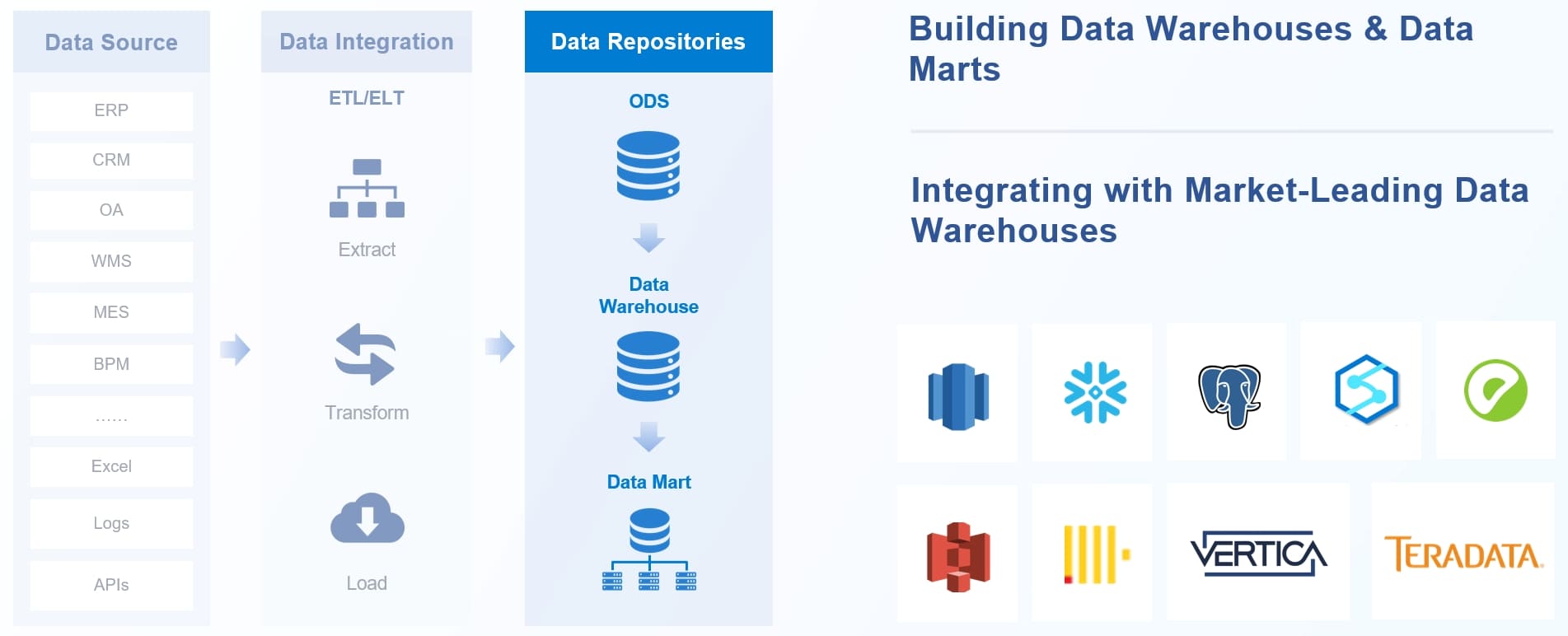
Assessing Business Needs
You should start by understanding your organization’s unique requirements before selecting a cloud data warehouse. Follow these steps to ensure you choose the right platform:
- Identify your business goals and the specific data you need to support them.
- Research different cloud data warehouse providers and review client feedback.
- Check if the solution can scale with your current and future needs.
- Make security and compliance a top priority to protect your information.
- Review your existing tools to ensure the new cloud data warehouse integrates smoothly with your current systems.
A clear assessment helps you avoid costly mistakes and ensures your cloud data warehouse supports your business growth.
Budget and Total Cost
When you evaluate the total cost of ownership for a cloud data warehouse, look beyond just the subscription fees. Consider these factors:
- The quality of the technology stack and whether it uses microservices for better scalability and cost efficiency.
- Costs related to disaster recovery and business continuity.
- The complexity of change management and the number of IT staff or business analysts required.
- The vendor’s support model, including self-service options for business users.
- Integration capabilities, such as support for Kafka or other distribution technologies.
You should also account for infrastructure costs, data engineering labor, and the impact of performance on insight delivery. A cloud data warehouse with a modern architecture can lower costs by reducing manual ETL/ELT work and speeding up time-to-insight.
Tip: Always calculate both direct and hidden costs over the full lifecycle of your cloud data warehouse.
Scalability and Future-Proofing
Scalability is essential when you select a cloud data warehouse. Enterprise Data Warehouses integrate data from many sources, including legacy systems, and use layered architectures to handle growing data volumes. Cloud computing lets you scale resources up or down as needed, so you only pay for what you use. Automated scaling in a cloud data warehouse means you do not need to manage infrastructure manually.
You should plan integration carefully, starting with a roadmap and gradual implementation. Monitor performance metrics to spot bottlenecks early. Choose a cloud data warehouse that supports horizontal scaling, load balancing, and data replication for reliability and speed. Cloud hosting offers flexibility, cost savings, and disaster recovery, making it the preferred choice for future-proofing your data management strategy.
Vendor Ecosystem and Support
A strong vendor ecosystem can make your cloud data warehouse more valuable over time. Leading platforms like AWS Redshift and Snowflake offer integrated tools, partner solutions, and managed services. These features help you connect your cloud data warehouse to other systems, reduce complexity, and avoid vendor lock-in. Reliable vendor support helps you solve integration challenges, optimize performance, and keep your cloud data warehouse running smoothly. Ongoing training and partnerships ensure your team can adapt to new business needs and technology changes, supporting long-term success in data management.
FanRuan FineDataLink for Modern Data Warehousing Solutions
Real-Time Data Integration
You need your modern data warehouse to deliver up-to-the-minute insights. FineDataLink gives you real-time data integration, so you can synchronize information across more than 100 sources with minimal delay. You see changes reflected in your analytics almost instantly. This capability helps you make decisions based on the latest data, not yesterday’s numbers. FineDataLink’s architecture supports fast data integration, which means you can handle high transaction volumes without slowing down your business.
With FineDataLink, you reduce manual work and keep your modern data warehouse always up to date.
ETL/ELT and API Capabilities
You want to transform and move data efficiently. FineDataLink provides powerful ETL and ELT tools that let you clean, process, and load data into your modern data warehouse with ease. You use a visual, drag-and-drop interface, so you do not need to write complex code. You can also build and launch APIs in minutes. This feature allows you to connect your modern data warehouse to SaaS applications and other systems quickly. You gain flexibility and speed, which helps you adapt to changing business needs.

Use Cases and Industry Applications
You can apply FineDataLink in many industries. In retail, you track sales and inventory in real time. In manufacturing, you monitor production and supply chain data for better efficiency. Financial services use FineDataLink to unify customer and transaction data, which improves risk management. Healthcare organizations rely on it to integrate patient records and support compliance. You benefit from a modern data warehouse that adapts to your industry’s demands and supports your growth.
You see cloud data warehouse solutions dominating in 2025, offering unmatched scalability and flexibility for every business size. Serverless options like Google BigQuery reduce overhead, while unified platforms such as Databricks Lakehouse support both structured and unstructured data. When you select a cloud data warehouse, match your needs for integration, real-time analytics, and ease of use. FanRuan FineDataLink stands out if you want efficient, scalable data integration for your modern cloud data warehouse. Try a demo or consult an expert before you choose your next cloud data warehouse.
Click the banner below to try FineDataLink for free and empower your enterprise to transform data into productivity!
Continue Reading About Data Warehousing Solutions
Unlocking Success with Data Warehousing and Business Intelligence
FAQ

The Author
Howard
Data Management Engineer & Data Research Expert at FanRuan
Related Articles

10 Best Data Orchestration Tools for 2025 You Should Know
Compare the best data orchestration tools for 2025 to streamline workflows, boost automation, and improve data integration for your business.
Howard
Nov 28, 2025

10 Best Enterprise ETL Tools for Data Integration
Compare the 10 best enterprise ETL tools for data integration in 2025 to streamline workflows, boost analytics, and support scalable business growth.
Howard
Oct 02, 2025

What is Real Time Data Integration and Why It Matters
Real time data integration connects systems for instant, accurate data access, enabling faster decisions, improved efficiency, and better customer experiences.
Howard
Sep 24, 2025
